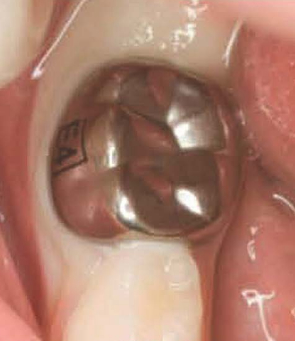
Stainless Steel Crowns: A Stronger Way to Repair Decayed or Underdeveloped Back Teeth
Stainless steel crowns are metal caps made from a combination of stainless steel, nickel, and chrome. These crowns are often used to treat back teeth (molars) that have either decayed or not formed properly due to hypomineralization. They are a more durable option than traditional fillings and offer stronger protection to the tooth.
Pre-made in the shape of the tooth, stainless steel crowns come in a range of sizes. Our dental team selects a crown that will fit over and cover the entire tooth that sits above the gumline.
Crowns can help protect the tooth from further decay and create space in the mouth for adult teeth to grow. Children who need stainless steel crowns typically fall into one of the following categories:
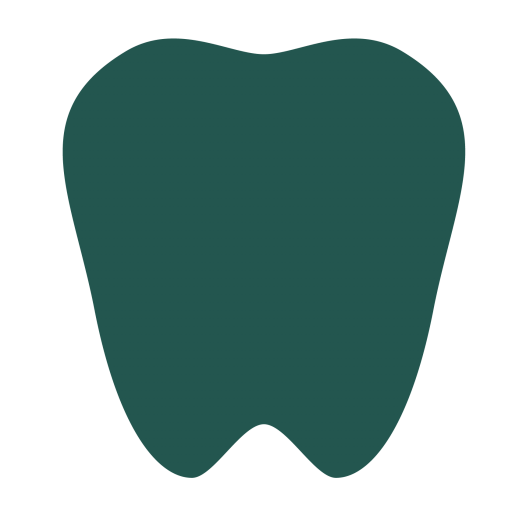




Before
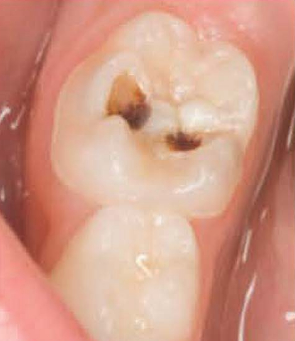
After

Stainless steel crowns have a shiny, silver appearance and are commonly placed on back molars, making them less noticeable than you might expect. Children are often pleased to have a “pirate tooth,” “princess tooth,” “transformer tooth,” “silver cap,” or “hat.”
In general, the crown should remain in place until the baby tooth falls out naturally as the adult tooth erupts. However, in rare cases, the crown may need to be removed or replaced before the tooth falls out.
The procedure for placing a stainless steel crown may or may not require local anesthesia. In some cases, the crown can be slotted over the tooth without extensive decay removal. If the crown does not fit properly, the tooth will be shaped to fit the crown. If nerve/root treatment is required, extensive decay removal and local anesthesia will be necessary before crown placement. Elastic bands are sometimes used to create a small space between the teeth, which allows the crown to be properly seated without shaping the tooth.
After the crown is placed, it should be treated like a normal tooth. Children should brush it twice a day along with their other teeth to maintain proper oral hygiene.
Overall, stainless steel crowns offer a strong and durable solution for repairing decayed or underdeveloped back teeth in children. Talk to your dentist if you think your child might benefit from this treatment.
Silver Diamine Fluoride
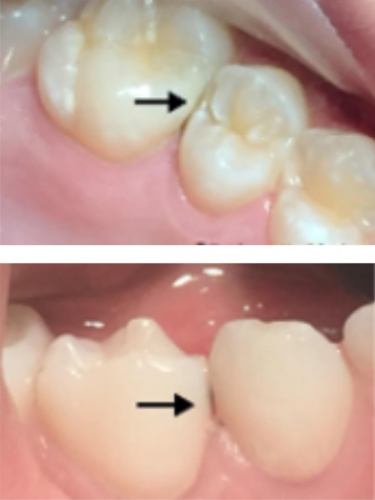
Silver fluoride and Tooth Dental
Silver fluoride is a type of chemical compound that contains both silver and fluoride ions. It is represented by the chemical formula AgF and appears as a white crystalline solid that is easily soluble in water.
The dental industry primarily uses silver fluoride as a preventive agent against cavities. The compound is applied as a topical solution or gel to the surface of the tooth, where it reacts with the hydroxyapatite in the tooth enamel to form a protective layer of silver phosphate. This layer is highly resistant to acid attacks by bacteria present in the mouth, thus preventing the formation of cavities.
It is important to note that silver fluoride can be toxic if ingested in large amounts or inhaled as a dust. Thus, proper safety measures must be taken when handling the compound.
Aside from its primary use in cavity prevention, silver fluoride also offers other benefits such as strengthening the structure of the tooth enamel by forming a layer of silver phosphate. This can help to prevent the development of new cavities and alleviate tooth sensitivity. Additionally, silver fluoride can promote remineralization, a process where minerals such as calcium and phosphate are incorporated into the tooth structure, thus restoring its strength and integrity. The compound also has antimicrobial properties that help to prevent the growth of bacteria and other microorganisms in the mouth, reducing the risk of tooth decay and gum disease.
It is crucial to emphasize that the use of silver fluoride should be supervised by a dental professional. Additionally, appropriate safety precautions must be observed when handling the compound to avoid potential risks.
Pros





Cons




Silver Fluoride
treated molar
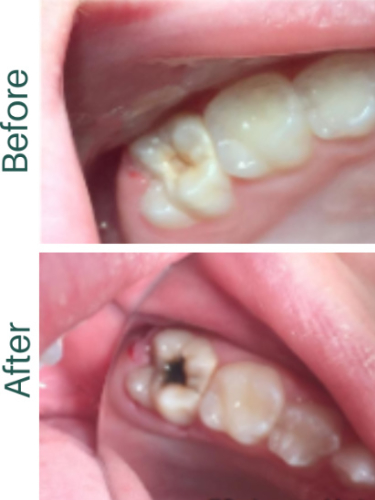
Silver Fluoride treated interproximal lesion

What’s an Oral Health Therapist?
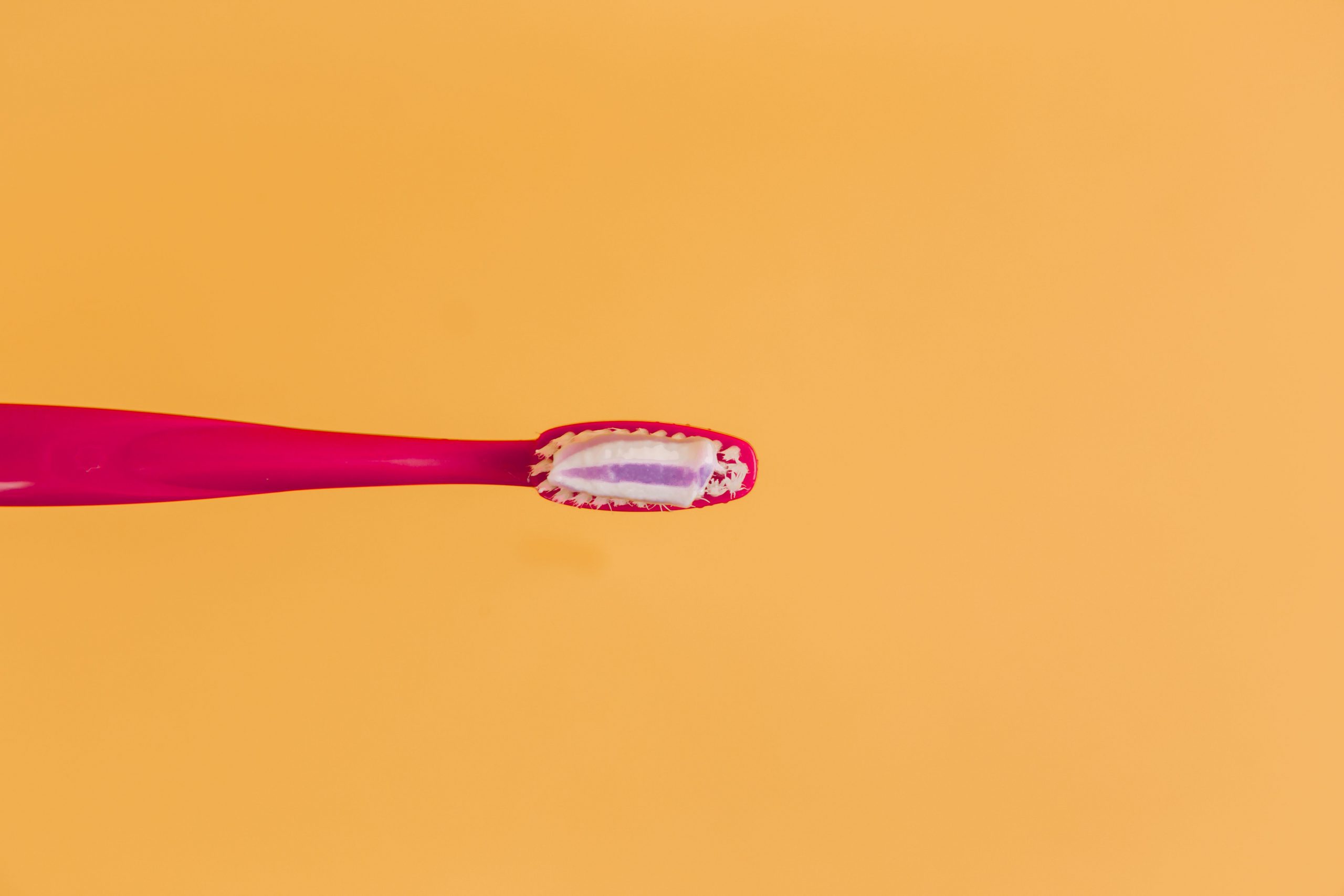
 Oral Health Therapists (OHTs) are dental clinicians qualified in both dental therapy and dental hygiene.
Oral Health Therapists (OHTs) are dental clinicians qualified in both dental therapy and dental hygiene.
Your Oral Health Therapist will be pleased to help you with tooth issues like examination, routine dental treatment, and preventative work. For example, this would include taking X-rays, fillings, fissure sealants and deciduous tooth extractions. They can also help stabilise and maintain gum health in patients of all ages, whether they are currently experiencing gum disease or not.
OHTs play a vital role in oral health protection, working towards improving oral health in patients through education and therapeutic measures. OHTs are responsible for mouth health awareness, prevention, and, where necessary, an early intervention system for oral diseases. OHTs are able to provide full care for patients of all ages. When necessary, they can refer specific cases to general dentists and dental specialists, ensuring optimal care.
For adults, your dentist and OHT complement each other in the services and care they provide. Your dentist will focus on diagnosis and the completion of routine or complex treatment plans, and your Oral Health Therapist will assist in the stabilisation and maintenance of your oral health.
How do a Dentist and Oral Health Therapist work together?
Using two practitioners means you will have an efficient and professional experience at the dentist. They work together to ensure a thorough and gentle dental maintenance appointment. The Dentist will review X-rays and photographs taken by the Oral Health Therapist. They will then examine all teeth and surrounding soft tissues.
The Oral Health Therapist will spend extended time with each patient to create a personalised experience and edify patients on home care routines. Your dentist will check for gingivitis and other oral diseases. After finishing up with a hygiene clean, fluoride treatment (where required) will be applied to your teeth. Lastly, you will sit down with your dentist and discuss any issues you may have, and plan/make an appointment for future maintenance appointments.
If you have any other questions or would like to book an appointment please contact the friendly team at Tooth Dental; we’d love to hear from you!
Health Effects of Vaping & E-cigarettes

 What is a Vape?
What is a Vape?
E-Cigarettes are battery-powered electronic devices which heat liquid (E-liquid) and produce an aerosol inhaled by users (termed “vaping”). The main ingredients of E-liquids include: propylene glycol, glycerol as humectants, flavouring and often nicotine.
Oral Health Effects
There is little evidence as to the effect E-cigarettes have on oral health. However, E-cigarette companies claim use of these products can improve oral health by providing an alternative to conventional smoking. 2
Mouth and Throat
A variety of symptoms involving lips, tongue, hard palate and soft tissues were reported by E-cigarette users. Most commonly patients reported: dryness, burning, irritation, bad taste, bad breath, pain, oral mucosal lesions, black tongue and burns. Studies comparing E-cigarette and CC symptomatology showed less adverse effects were experienced by E-cigarette users, with some former smokers citing improvements in taste and mouth odour. Non-smokers using E-cigarettes reported greater levels of oral discomfort compared to those utilising nicotine replacement therapy.
Mucosal changes secondary to E-cigarette use appeared to be minor and temporary. Specific impacts relating to E-cigarette flavours were noted. Menthol and cinnamon were associated with increased mouth irritation, and throat symptoms increased with citrus, sour, cola and custard. Nicotine increases short-term blood flow to mucosal tissues, with the suggestion menthol may act to mask airway irritation likely caused by high nicotine levels.
Is it safer for me to use E-Cigarettes than smoking conventional cigarettes?
No. There is insufficient evidence to say it is safer, hence if you are a non-smoker it is not safe to use them.
Do you recommend that I use E-cigarettes to help me quit smoking?
In isolation, no. However, as a smoking cessation tool E-cigarettes may potentially be effective when combined with a structured ‘quit smoking’ plan. This involves combining the use of E-cigarettes with other evidence based behavioural therapies and counselling. Involving your GP and national smoking cessation services as a combined approach is the most effective strategy irrespective of the cessation tool (eg: E-cigarettes, nicotine patches etc).
Is Vaping dangerous to my dental and oral health?
Yes. The oral effects of E-cigarettes based on use by non-smokers may include: mouth and throat discomfort, oral mucosal lesions, changes in the
oral microbiome, dental and periodontal damage. There is also evidence that vaping can cause changes at the cellular level of oral tissues, and that
constituents of E-liquid/vapor and downstream metabolites of these constituents have potentially dangerous genotoxic and carcinogenic
properties. Thus, there is likely to be an increased risk of oral and oropharyngeal cancer. Furthermore using an electrical device with a battery
carries a risk of explosion, causing traumatic injury which could cause permanent harm.
Is it better to ‘vape’ rather than smoke cigarettes after I’ve had dental/oral surgery?
It is recommended to refrain from smoking or vaping for as long as possible after oral surgery. Conventional smoking is thought to damage healing
mechanisms, affect blood vessels, and contribute to poor filling of the tooth socket with blood. Regarding dry socket (Alveolar osteitis), no studies exist to enable a comparison between E-cigarettes and CC on this topic at present.
Dentistry that doesn’t cost the Earth
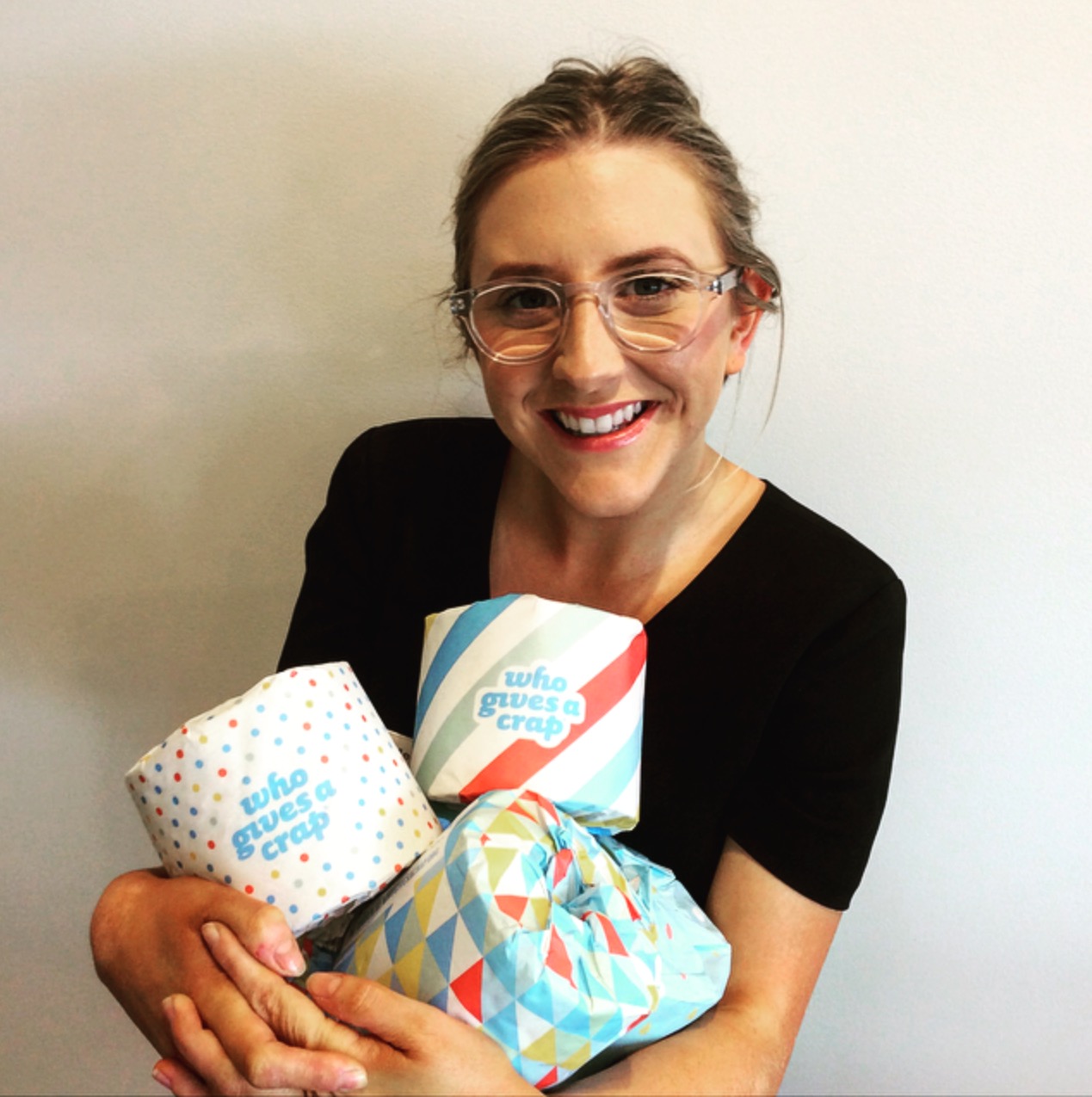
 At Tooth Dental we believe that dentistry shouldn’t ‘cost the Earth’. In 2015 when Dr Lou set up Tooth Dental, she wanted to make the practice as ECO Friendly as possible.
At Tooth Dental we believe that dentistry shouldn’t ‘cost the Earth’. In 2015 when Dr Lou set up Tooth Dental, she wanted to make the practice as ECO Friendly as possible.
Our eco ethos doesn’t affect our high standard of dentistry, strict infection control procedures or patient care, it simply means that at each stage we have considered how we could reduce our carbon foot print from the reception, tea room, the surgeries, sterilisation room and even the bathroom!
Our aim is to reuse, recycle and reduce our waste, water and energy as much as possible.
Reception and patient lounge:
- We use LED lighting were possible.
- We aim to be paperless and opt out of paper correspondence wherever possible. All our medical history forms are conveniently completed on an ipad, saving time and paper
- We recycle all our toners and batteries at appropriate facilities.
- Any professional printing is done on recycled paper or stock card (but we’d still prefer to just email)
The tea room:
- Our staff created a policy for no disposable coffee cups, water bottles and takeaway containers. We love our keep cups!
- We have a comprehensive recycling system. All food waste is placed in our Bokashi bin and then used to fertilise our plants and gardens. All cardboard, plastic and bottles are separated and recycled. We are working really hard to minimise what goes into our general waste
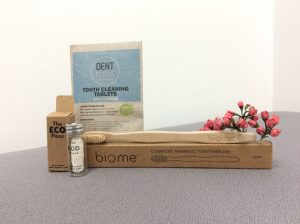 In the Surgery:
In the Surgery:
- Dentistry is traditionally a large contributor to single-use plastic. We use reusable instruments and materials wherever possible. If it can be autoclaved, we use it!
- We don’t offer amalgam fillings, all our composite resin fillings are free from Bisphenol A (BPA)
- We said no to paper/ plastic cups! Our patient cups are all stainless steel and are autoclavable.
- We use digital radiographs, eliminating the need for film and disposing of hazardous developing chemical. Plus reducing radiation exposure for patients.
- Our patient packs are no longer in paper bags, we said goodbye to patient brochures and simplified the pack.
- We offer great ECO and biodegradable alternatives to traditional oral care products (Eco Floss, Bamboo tooth brushes and tooth paste tablets)
- We use autoclavable microfibre cloths in the sterilising room, rather than paper towel or single use microfibre towel
In The bathroom:
- We use cotton hand towels in our bathroom, these are washed and line dried.
- Our toilet paper is 100% recycled by Who Gives a Crap
Things we are working on changing:
- Changing all of our lab impressions to a digital scanner, reducing impression material, packaging and transport.
We are continuously looking at new and improved ways to reduce our footprint, if you have any suggestions, we’d love to hear them!
Oral Care Product Recycling
We are a proud collector for the Terracycle Colgate Oral Care Brigade. We encourage all patients to bring their used oral care products to their next appointment. Anyone from the local community (you don’t have to be a patient) is welcome to drop their dental products in our recycle bin free of charge. We have even got some of our local Kindy’s involved helping us collect products!
We donate all proceeds from our recycling program to a children’s charity, The Starlight Foundation.
What can be recycled?
Any brand of:
- Empty floss containers
- Cardboard packaging from toothpaste & toothbrushes
- Empty toothpaste tubes and pumps
- Electric toothbrush heads
Sugar, Acid and your teeth.
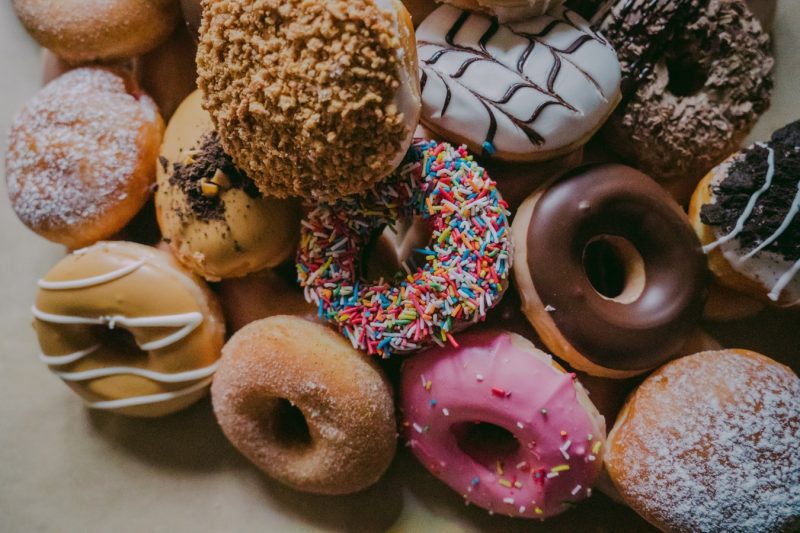
There are 2 things in your diet that have an effect on your teeth:
- Sugar
- Acid
It is not only the QUANTITY of them you consume, but also the FREQUENCY that effects your teeth. If you keep sugary foods and acidic drinks to meal times rather than snacking and sipping in between meals, it will have less of an adverse effect on your teeth than having them throughout the day.

Sugar, diet and your teeth
Acid is produced when the bacteria in your mouth break down sugar. The acid dissolves the tooth surface, which is the first stage of tooth decay.
Examples of sugary foods:
- Soft drink and Energy Drinks
- Flavoured milk
- Biscuits and Cakes
- Chocolate and Lollies
- Certain breakfast cereals and cereal bars
If you want to check how much sugar is in food, check the packaging label before you buy. The ‘carbohydrates of which sugars’ tells you mow much sugar is in food.
- More than 22.5g of sugar per 100g is high
- 5g of sugars or less per 100g is low
Acid
Acid in drinks slowly dissolves your teeth causing wear. It is very important to limit the amount of acidic drinks you have
Examples of acidic drinks:
- Lemon/citrus fruits added to water
- Fizzy drinks including soda water
- Fruit juice
- Wine
Do not to brush your teeth for at least 30 minutes after having an acidic drink. Acidic drinks weaken your tooth enamel, so brushing too soon can actually cause more damage.
You can reduce the impact of acidic drinks by rinsing your mouth with water after to dilute the acid.
Why straighten my teeth?

Why straighten my teeth? Let’s get a few things straight!
There are various reasons why people chose the orthodontic route. These include:
- Aesthetics
- Function and speech
- Periodontal
- TMJ pain
- Even wear
- Pre – prosthodontic work
It’s important to remember that no one ever died from crowded teeth, so have a think about what’d you’d like to do if your crooked teeth aren’t impacting on your life.

Braces VS Invisalign
The traditional braces we are used to seeing every second teenager sporting originally started in the 1970’s, although back then they looked dramatically different to the modernized style that is used now. They work by gluing ceramic or metal brackets to each tooth that are connected along a wire by a series of rubber bands.
Invisalign came about around 1999. They are more often than not chosen by adults who don’t want an obvious indicator that they are undergoing orthodontic treatment. Invisalign works by a series of custom clear plastic retainers, each slightly different from the first. The aligners are worn for 22 hours a day and changed every two weeks.
Permanent VS removable
There are pros and cons to both options, it’s important to weigh both of these up before making your decision. Braces are permanently fixed to your teeth for the duration of the treatment, thus they are working around the clock, all the time, 24/7. The downside is that they take more time to clean and are quite visible. Having braces involves monthly visits with the possibility of emergency visits such as a wire trying to murder you or a bracket has decided it wants to be free and fall off. And showing your last meal every time you smile if
Invisalign are removable and because of this it is much easier to eat and clean your teeth. Also, because they are clear retainers they are harder to see, the only people who normally notice are those in the dental field or fellow recipients of Invisalign. The downside is because they are removable, they don’t work if they are not in your mouth. If they are not in your mouth, they are no longer doing their job and you either lose all your hard work or dramatically extend your treatment time.
This being said teeth will move whenever a force is applied to them and are oblivions as to what that force is, braces or Invisalign. Theoretically the length of time for treatment should be the same but as braces are more reactionary and can’t be removed they are usually finished before Invisalign. The factors that do come in to play are things such as:
- Severe malocclusion (a fancy word for the teeth not sitting together properly)
- Compliance
- Complexity
- Hygiene
- Cost
- Discomfort
After weighing up the pros and cons you can see that there are many similarities. If you feel self-conscious, then Invisalign might suit you better. If you are interested in straightening your teeth, book in for a complimentary Invisalign consult.
Maintenance is relatively simple, however it can be time consuming. Every time you eat or drink anything other that water the trays need to be removed and teeth cleaned and the aligners washed before putting them back in your mouth.
Uh Oh! Need an Emergency Dentist in Ashgrove?
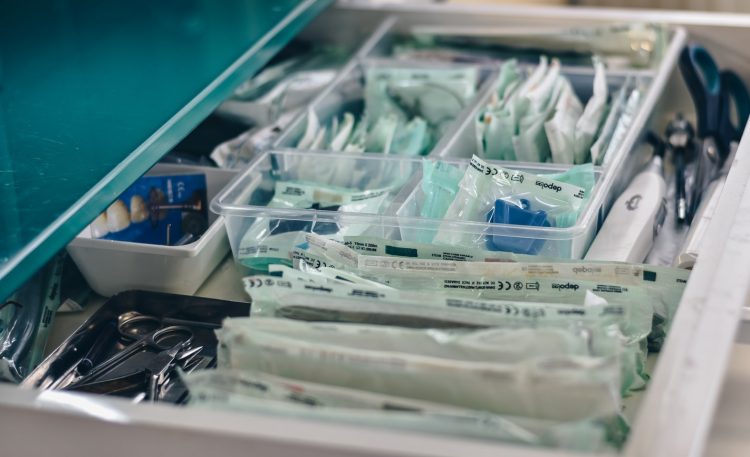
Looking for an emergency dentist in Ashgrove? Please read on. In any case of dental emergency it is very important to contact the dentist as soon as possible to try and find out if the situation requires immediate treatment or if it can wait until morning. An emergency trip to the dentist can be required for many reasons including an aching tooth, trauma, a broken tooth or a facial swelling.
In cases of dental trauma, such as if you’ve tripped over and broken your front tooth, treatment is recommended within 60 minutes in case the nerve of the tooth has been exposed. Immediate dental treatment is also needed for teeth that have been pushed out of position, into the gums or knocked out completely. This is a true emergency and immediate treatment can help save your tooth or teeth.
A chipped or broken tooth is often a pain, like when you bite down on a fork by mistake or crunch on a nut and something extra crunchy comes out with it. This tooth or teeth will often need attention within a couple of days if its painful, or within a week if its not painful. Left untreated you can have food packing into the broken area, decay and gum swelling can develop. We can usually fix your tooth right up and prevent all these problems.
An aching tooth can be absolutely awful. It can keep you awake at night, making you tired and just feeling dreadful. Often aching teeth are the result of decay making its way deep into the tooth close to the nerve. This happens over time, and left unchecked can cause nerve pain or even an infection or abscess. The best thing to do is to get your tooth looked at by the dentist within a couple of days. It can be just a filling in some cases, but is usually something more involved and the sooner you get to it the easier it is to fix. To prevent these kinds of aches regular checks and cleans help to prevent cavities or treat them nice and early so its simple and easy.
A facial swelling in the lower face is often an abscess or infection of the gums or tooth that has spread to the cheek. This infection needs to be addressed quickly as the infection can spread beyond the cheeks below the chin and can become life threatening. Your dentist may need to drain the swelling, prescribe antibiotics, remove a tooth or start a root canal treatment to save the tooth.
In cases of dental emergency, don’t wait. Get in contact with the dentist as soon as possible to find out what you need to do. If you need an emergency dentist in Brisbane please click here to book online or call 3366 1737.

All About Tooth Sensitivity
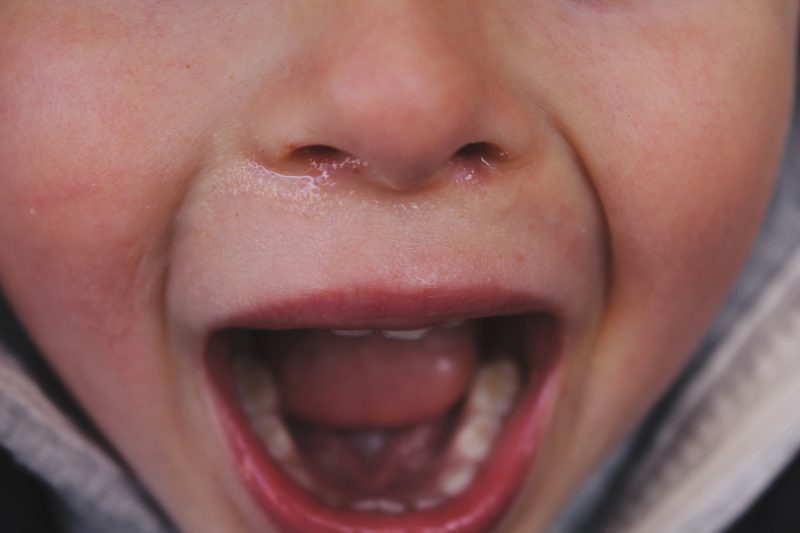
Tooth sensitivity is experienced as a short sharp pain when consuming cold, sweet or acidic foods and drinks. It can also be experienced with an intake of cold air or by touching the tooth.
All About Tooth Sensitivity
Sensitivity happens when the dentine layer, the layer underneath the enamel, becomes exposed. The dentine layer of the tooth is composed of small tubules that move fluid in response to changes in the tooth’s external environment like when eating or drinking. These tubules connect directly with the pulp of the tooth which is where the nerve is located causing the sensation of pain.

The dentine layer can become exposed if the teeth have been brushed too hard causing the enamel layer to thin. Or if brushing has caused the gums to recede away from the tooth, exposing the cementum or the root surface of the tooth. It can also become exposed if a diet high in acidic food or drink or even reflux causes the enamel to dissolve
Treatment of sensitivity involves addressing the cause. It may mean switching to a soft toothbrush, using a lighter tooth brushing technique, or re-evaluating your diet. We always recommend a toothbrush should look fresh out of the packet despite months of use. If it’s a little worse for wear, please change it! Poor/overzealous brushing technique leads to gum recession and enamel abrasion.
Sometimes the use of a sensitive toothpaste can alleviate the symptoms, or a small filling is required to block the dentine tubules and protect from further damage.
A trip in to see us is always recommended as other causes of sensitive teeth can be caused by decay, grinding or clenching, cracks in teeth or leaking fillings.
Any questions? Can the friendly team at Tooth Dental help you with a sensitive teeth issue? Please click here to make an online booking or give us a call on 3366 1737. If you’d like to use our contact form for your enquiry please click here.
All About Baby Teeth
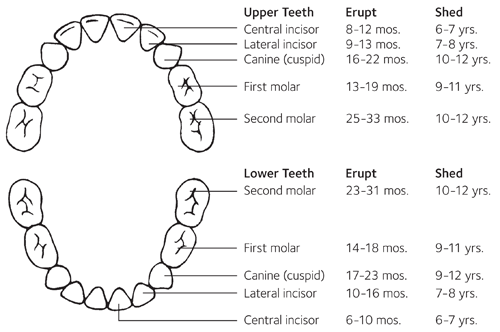
It’s an exciting time when your child gets their first tooth, but all of a sudden there is something else to look after. Along with the sleep deprivation and copious amounts of drool due to teething we start worrying about their teeth. Is it coming through in the right position? What is that weird looking spot? Why is my child shoving their whole fist in their mouth?
Here is some information to try and ease your mind.
All About Baby Teeth
Generally your child will develop their first tooth by the age of one, although this can vary from not yet having any teeth to being born with their first tooth already. The baby teeth continue to come through until the age of 3 having a total of 20.
Around the age of 6 is when the first adult tooth starts to come through and baby teeth start to fall out. This will continue until around the age of 10-12 where all the adult teeth bar the wisdom teeth will have come through and the last of the baby teeth will have fallen out. Normally there will now be a total of 28 teeth.
Please have a look at this baby teeth eruption chart prepared by the American Dental Association:

Cleaning baby teeth
Start with a washer over your finger on the gums. When teeth first appear brush twice a day using a soft tooth brush and low fluoride kids toothpaste. (eg. Milk teeth, Colgate first). Since babies naturally swallow the toothpaste do not use adult toothpaste. Start flossing once the teeth are touching, often when molars are through.
Early loss of baby teeth can be from anything such as decay or trauma and can result in orthodontic concerns. Decay can be prevented by fluoride application which helps strengthen the enamel. It should be introduced to the enamel from about 6 months old through tap water and low fluoride toothpaste. If a baby tooth does fall out the space can be maintained to allow the adult tooth to come through properly.
Their first dental visit can start from when the first couple of teeth come through when you have your appointment. Getting them used to the sounds and environment, maybe sitting on your lap and letting the dentist have a quick look at their teeth and slowly progressing to them laying back in the chair and have a clean done. If at first they won’t allow this try not to stress, they will eventually. What’s most important is that they leave with a positive experience and have enjoyed their visit.
